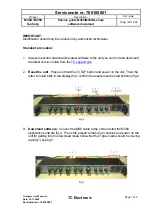
Figure 38.
Case 2: Dynamic Temperature Ramp
The link is brought up with initial adaptation at a static temperature (low).
Temp
Temper
atur
e Ramp
Initial Adaptation
and Continuous Adaptation
Tuning RX AFE Parameters
Will Bridge the Gap
BER
The temperature is increased with continuous adaptation running in the background.
Continuous adaptation is required in dynamic temperature conditions and its adaptive
range is highly dependent on initial adaptation conditions. The goal of continuous
adaptation is to compensate for temperature changes and ensure the link performance
is as near as possible to the initial adaptation performed at the low temperature in
Case 2. As the temperature increases, the eye degrades at the sampler and reports a
relatively higher BER. Continuous adaptation started at a lower temperatures does not
result in the optimal performance observed at higher static temperature in Case 1
after running initial adaptation. This implies that continuous adaptation is unable to
maintain the performance obtained after running initial adaptation.
You can reduce this link performance degradation between the static temperature
(Case 1) and dynamic temperature (Case 2) conditions by tuning the PMA AFE
parameters. This establishes the desired dynamic temperature performance of
continuous adaptation close to the initial adaptation at high temperature.
3.1.3.2. PMA Bring Up Flow
Static temperature flows (STF) and dynamic temperature flows (DTF) have different
processes for successful link bring up.
The DTF link bring up flow is used in real time scenarios to compensate for dynamic
temperature conditions. Unlike STF, DTF link bring up runs continuous adaptation to
maintain link performance over the dynamic temperature conditions. Configure the
PMA parameters before running initial adaptation and continuous adaptation to extend
the adaptive range of PMA in DTF link bring up.
3. Intel Stratix 10 E-Tile Transceiver PHY Architecture
UG-20056 | 2019.02.04
Intel
®
Stratix
®
10 E-Tile Transceiver PHY User Guide
69
















































